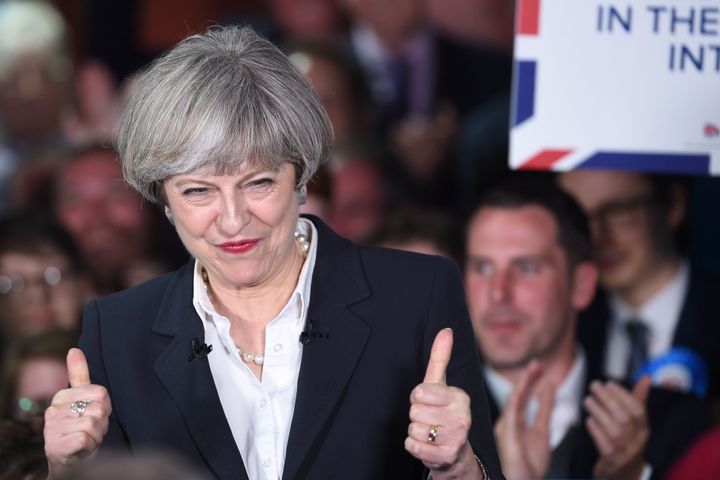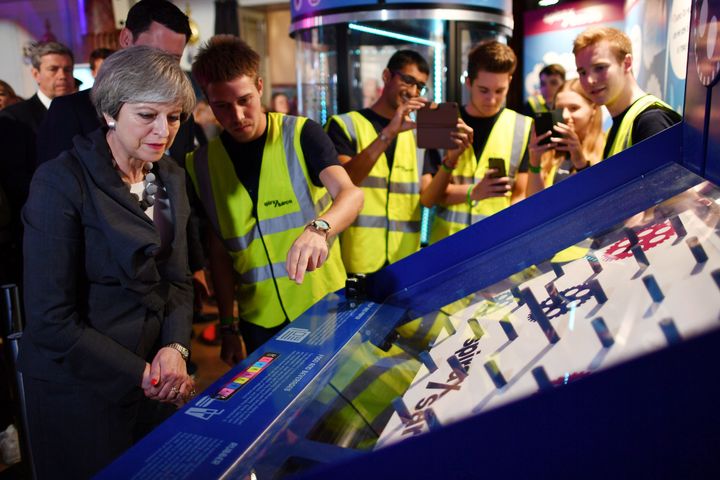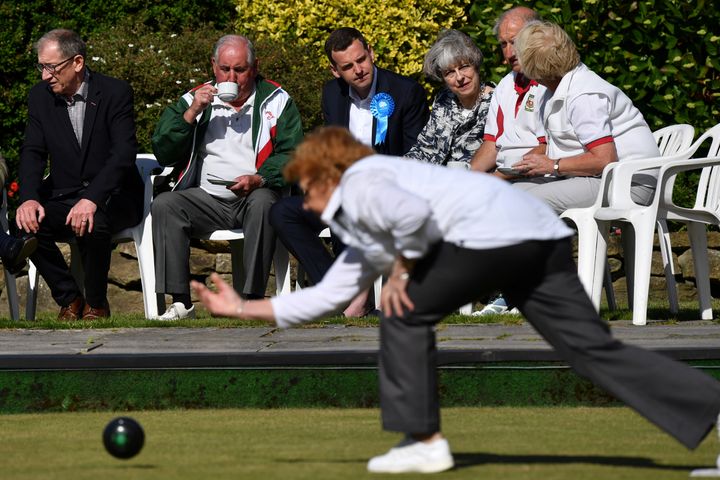The black Range Rover sped past the bus as it headed on to the motorway to Preston.
Just as it nosed in front, a hand emerged through the sunroof and made three clear signals in our direction: middle finger, two fingers, wanker gesture.
That’s the problem with travelling on a bus with ‘Theresa May: For Britain’ on the side: it tends to provoke a reaction.
Half an hour earlier, and May had enjoyed a much friendlier response when she spoke to a small crowd of activists gathered together at the end of a room in Bradford’s Provident Rugby League ground in Odsal.
The Prime Minister bounded on to the make-shift stage at just after 8pm, with activists circled around her to give the impression of a much greater crowd than there actually was.

Despite the warm welcome, the crowd seemed subdued. May’s speech didn’t help.
She talked of the “great responsibility” of being in Government, the “challenges” facing the country and the need to build a “better Britain”. It was not a speech doused in optimistic rhetoric.
It didn’t seem like she was enjoying delivering it either, and her go-through-the-motions approach infected the crowd – who applauded at all the right moments but with no real enthusiasm.
This did not seem to be a leader on the cusp of an election landslide. How different from when the campaign began, when the talk was of whether Labour would be wiped out – not whether May would get a big enough win to justify calling this election.
The social care u-turn, questions over her record as Home Secretary, her no-show at the seven-way leaders’ debate – all seemed to undermine her “strong and stable” mantra in recent days and weeks.
And the nervousness, that little lack of self-belief, was coming across in May’s speech.
Thankfully for her, the emotional stalemate between speaker and audience ended when an activist cried out “Theresa May!” after the Prime Minister rhetorically asked: “Who has the plan to deliver Brexit for the British people?”
The crowd cheered, and May’s face broke out into something that has been rarely seen this campaign: a smile.
She even stepped forward to shake the hand of the activist, and the tension in the room dissipated.
It seemed May had needed that small moment of validation after a bruising few weeks.

After the speech had finished, we journalists were placed onto one of the two Theresa May battle buses and driven to Preston for an overnight stay.
The next day was non-stop traveling punctuated with glimpses of the Prime Minister.
She spent ten minutes in a bakery in Fleetwood, letting slip that she had a Saturday job in a bakers when she was younger.
Next stop was a farmhouse in the Labour held constituency of Clwyd South, where May met a handful of farmers, and recorded some clips for the broadcasters.
Another rally with activists in Stoke – again in a room double the size of the number of people – was followed by a brief visit to a science festival in Cheltenham
The biggest event of the day was rally in Slough, where Foreign Secretary Boris Johnson, leading Brexit MP Steve Baker and more than a hundred activists heard May vow to tear up any human rights laws which stood in the way of her plans to tackle terrorism.
How many ‘real’ people did she meet that day? Some of those at the science fair weren’t Tory activists, and perhaps one or two in the bakery, but it is fair to say May had avoided any unnecessary confrontations with the public. Nor had she addressed a rally teeming with thousands of supporters as Jeremy Corbyn frequently does.

While she avoided the public, it is not fair to say she completely avoided journalists. After speaking in Stoke, she took questions from the majority of us who were accompanying her on her trip.
Unlike at the beginning of the campaign, we did not have to put our names down on a list, and May had no idea what we would ask.
It seemed to be the one part of the day that was left to chance, the only moment where something genuinely spontaneous could happen.
It also seemed to be when May was at her most relaxed.
Having watched her on the stump, it’s clear she is not a natural orator. She is certainly not bad, and is able to stick to the message and get to the point much better than her Labour rival. But she lacks humour and wit, and is more comfortable with pragmatism than emotion.
That approach comes through when she interacts with non-political people. May has a habit of pausing after she’s been introduced to someone, waiting for them to initiate the conversation. Her head trembles slightly and its clear she is desperately searching her brain for a bland yet engaging question to ask to a conservation going: small talk, as most of us know it.
Luckily for her, she was able to bring along the charismatic part of her personality on the second day: her husband, Philip.
The 5.30am start at Smithfield Market in London perhaps demonstrated why May and her team were keen to filter out the public from her events as much as possible. One butcher booed and heckled her with cries of “Vote Labour!” as she perused the meat laid out before her.
A bowling club in Southampton was much more her scene, but even there it was Philip who had a smile on his face and seemed more relaxed when talking to the club’s patrons.
Little bits of Theresa May did she slip out – including the fact she doesn’t take milk in her tea. Another politician would have perhaps have made a joke about this very un-English characteristic in order to break the ice, but not May.
An internal flight then took us to Norwich, where May was whisked inside a non-descript building on a business park just outside the city.
Here she delivered a speech to activists (same format as always: room too big, people crowded round), and, as in Stoke, May took a host of questions from journalists.
I asked her if she was worried by the size of the crowds Corbyn was attracting, compared to the smaller, more stage-managed events she was taking part in.
“I’ve done all sorts of events. I’ve been into workplaces and actually talked to people in their workplace about the issues that matter to them and taken their questions and, yes, I’m here with activists today but this is the last stages of the campaign and I’m encouraging everyone to get out over the next 36 hours and get those votes out tomorrow.”
It was then off to a home furnishings shop just outside Nottingham, where again Philip appeared more relaxed as the pair met workers, before the drive to the final rally of the campaign in Birmingham.

May had made 11 campaign stops in 48 hours – but had barely met a real member of the public or made a speech to anyone who wasn’t already a Tory supporter.
But does it matter?
May’s visits may have been fleeting, but she was still hitting different areas of the country. That enables local Conservative candidates to tell voters the Prime Minister has taken a special interest in the seat and really wants to see it either turn or stay blue. It allows the local media to run stories about how the PM visited their particular patch so close to polling day. It provides clips for news bulletins showing what seems like a roomful of enthusiastic supporters.
There was something else that became clear while we were on the campaign trail with May: the shrewdness of the Tory press operation.
After we left Fleetwood on Tuesday morning, the journalists on the bus were given a story about how Labour’s plan to abolish the marriage allowance meant they had breached their promise not to raise taxes for those earning under £80,000.
After it was written up, May mentioned it in her speech in Stoke – making sure the story was ‘developing’. Labour did not provide a response to the claim until 8 hours after they were asked.
The story that dominated many of the front pages on Wednesday – that May would tear up human rights laws to tackle terrorism – was briefed out to journalists on the bus before she announced it in her speech.
The advanced knowledge of her speech helped it get a good showing in the press, and helped May wrestle back the news agenda the day before voters go to the polls.
May insisted she was enjoying the campaign, but there was little evidence of that. May called this election as she was warning of the Brexit storm clouds ahead. But she has brought little sunshine during the campaign to dispel them.
As the battle bus drove us from Nottingham to Birmingham for the final rally of the campaign, a blue Vauxhall Mokka pulled up alongside us and the driver honked the horn.
Both he and his passengers gave the bus the thumbs up.
An unprompted interaction from members of the public.
Perhaps Theresa May should have tried more of it.
